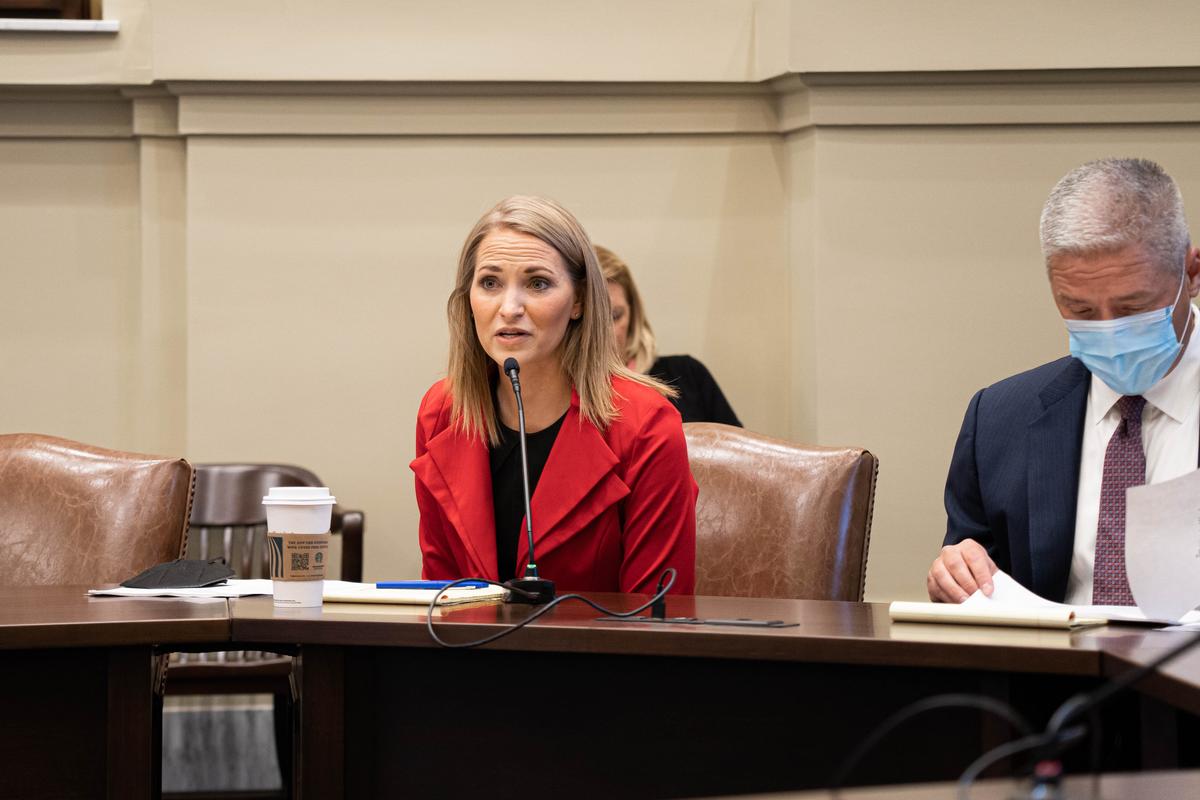In order to provide equal access and equal opportunity to people with diverse abilities, this site has been designed with accessibility in mind. Click here to view
Senate committee learns about roadblocks keeping Oklahomans from returning to work
 Sen. Carri Hicks, D-Oklahoma City, addresses the Senate Business, Commerce and Tourism Committee during her interim study Tuesday to learn why Oklahomans are not returning to work.
Sen. Carri Hicks, D-Oklahoma City, addresses the Senate Business, Commerce and Tourism Committee during her interim study Tuesday to learn why Oklahomans are not returning to work.
OKLAHOMA CITY – Sen. Carri Hicks, D-Oklahoma City, hosted an interim study Tuesday to learn what is preventing Oklahomans from returning to the workforce after the first year of the pandemic. The study was conducted by the Senate Business, Commerce and Tourism Committee.
“While the pandemic has added to our state’s workforce issues, it’s apparent through our study that it’s not necessarily the main problem,” Hicks said. “The workforce is changing, employees’ needs are changing and employers are going to have to rethink how they do business and the benefits they provide for their employees. Families need livable wages, access to affordable child care and assurances that their workplace has protocols in place to keep them safe from COVID-19.”
Presentations were made by the Oklahoma Policy Institute (OPI), Oklahoma’s Child Care Resource and Referral Agency, the Oklahoma City Chamber of Commerce, and the Oklahoma City Black Chamber of Commerce. According to the presenters, the groups most impacted by the pandemic have been women, especially minorities, young adults, adults with low education and low wage workers. The heaviest hit industries have been leisure and hospitality, health and education services, food services, and transportation.
OPI Policy Specialist Josie Phillips and Senior Budget and Tax Policy Analyst Paul Shinn shared four theories as to why people are not returning to the workforce. These include federal unemployment benefits disincentivizing workers; lack of child care; COVID anxiety; and low quality jobs.
OPI found the first theory to be without merit, citing a study of states that cut off federal benefits early only saw around a 2% increase in people returning to work, while losing the flow of additional funds into their local economies. The nonpartisan think tank noted findings supporting that the other three issues are major concerns and problems for workers and encouraged legislators to focus on addressing them to help Oklahomans be able to return to the workforce.
“The biggest component to getting Oklahomans back to work is giving them the freedom to do so. This means ensuring that their children are cared for while the parents are away, providing workers a job environment safe from COVID, and helping Oklahomans find jobs that can provide the security and dignity they deserve,” said Shinn.
Paula Koos, executive director for Oklahoma’s Child Care Resource and Referral Agency, verified OPI’s research on lack of child care and affordable child care as a major problem in Oklahoma. She said even before the pandemic, over half of Oklahomans lived in a child care desert, meaning there were no child care facilities in close proximity to families. She noted the following examples: Cimarron County has no centers; Beaver County has only three and Texas County has 20. With many child care centers shutting down during the pandemic, it is nearly impossible for families to get into one now. Working parents also struggle to find centers that offer nontraditional care before 6:00 a.m. or after 6:00 p.m., limiting what jobs they can apply for or forcing them to stay out of the workforce altogether. Koos noted that low pay and rigorous licensing and training requirements is deterring many from getting into the child care industry, further compounding the problem.
Executive Director for the Oklahoma City Black Chamber of Commerce Joanne Davis spoke about the problems facing small businesses, especially those owned by minorities and women. She said they are struggling financially, working to keep their customers and employees safe through increased safety protocols, changing their food and product options as market prices continue to skyrocket, updating their technology to better accommodate customers, and taking other steps trying to stay afloat. But often times, their work is in vain, though, as they are faced with a limited pool of workers. Once they get employees, quarantines, child care issues and other problems, typically leave them short-staffed further hurting their business. She explained it is a constant struggle for small businesses to compete in the ever-changing pandemic workforce.
“If small businesses can’t afford $15 to $18 an hour, provide health benefits or offer telework options, their pool of perspective employees is extremely low,” said Davis. “COVID has tenacles that are far-reaching and if we don’t address these issues, they will impact small businesses for years to come.”
Drew Dugan with the Oklahoma City Chamber of Commerce noted that Oklahoma City is almost back to full employment compared to 2019, with the city’s unemployment rate sitting around 3%. Through a survey of their approximately 3,500 members, the chamber has found that companies are changing how they do business due to the pandemic. Employers’ main concerns are finding and retaining qualified workers, keeping their employees and customers safe from COVID, and providing sufficient benefits that will make them competitive in the workforce. They also found that 10% of their members are planning to permanently continue remote work.
Sen. Hicks: (405) 521-5543 or Carri.Hicks@oksenate.gov
 Oklahoma Senate
Oklahoma Senate

